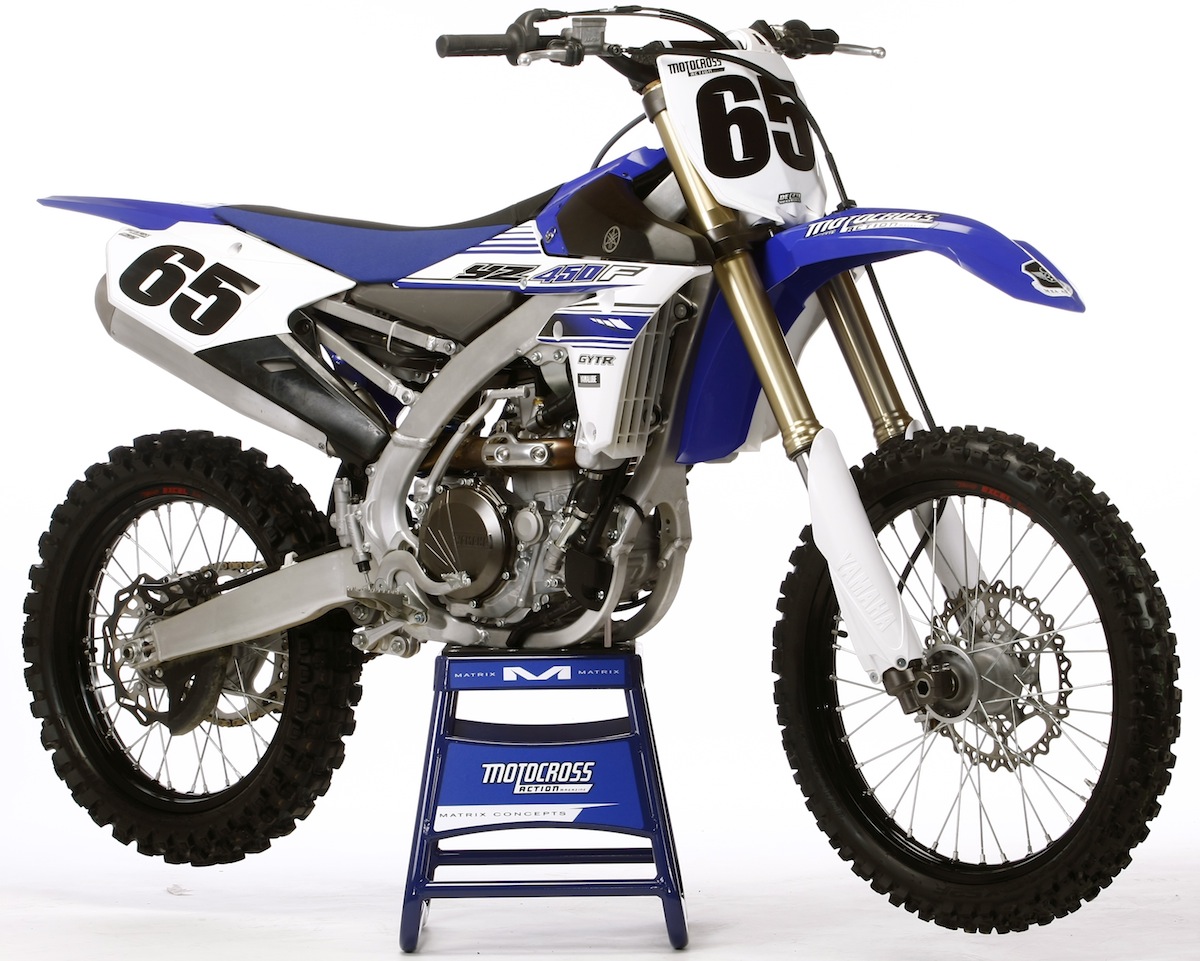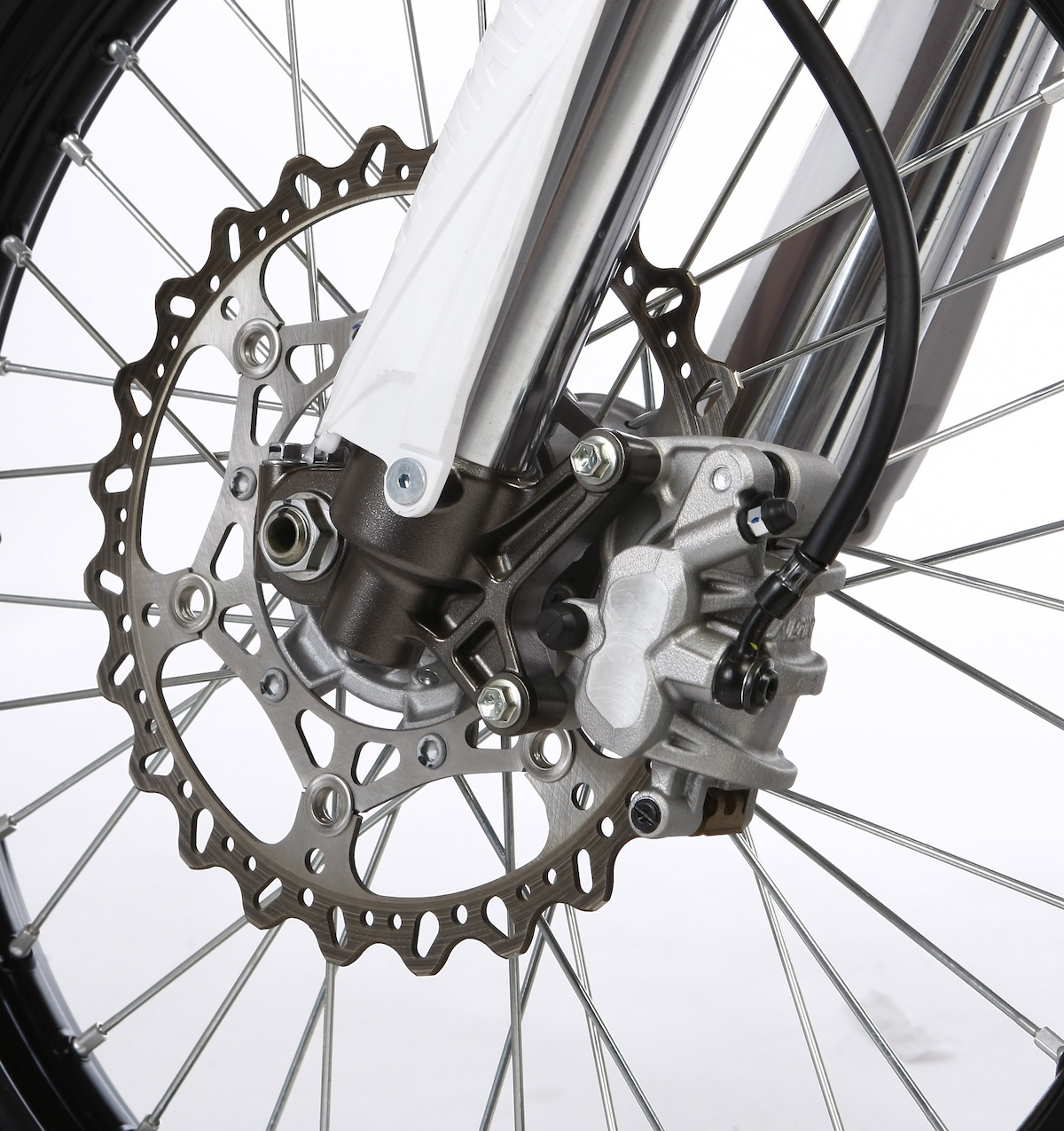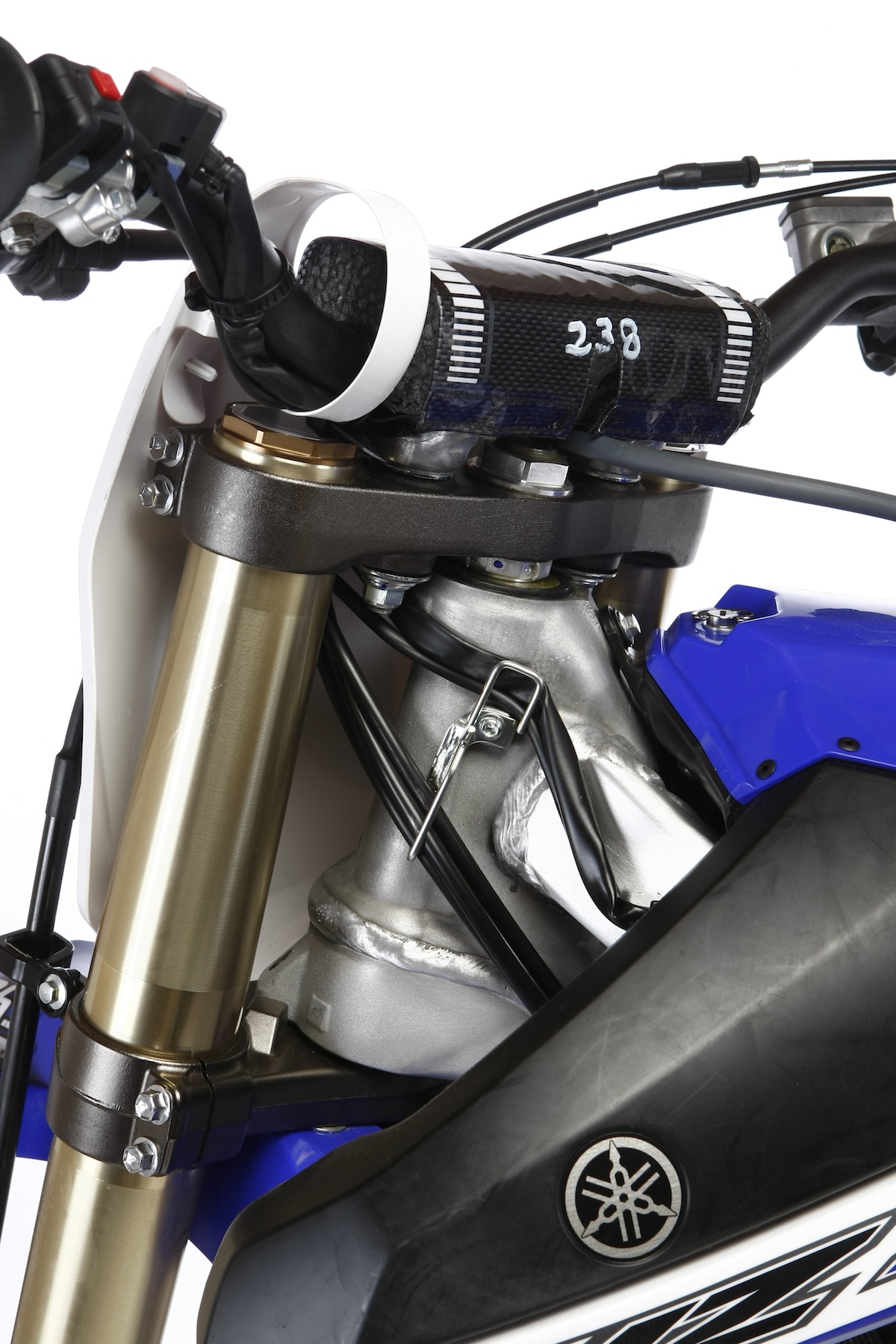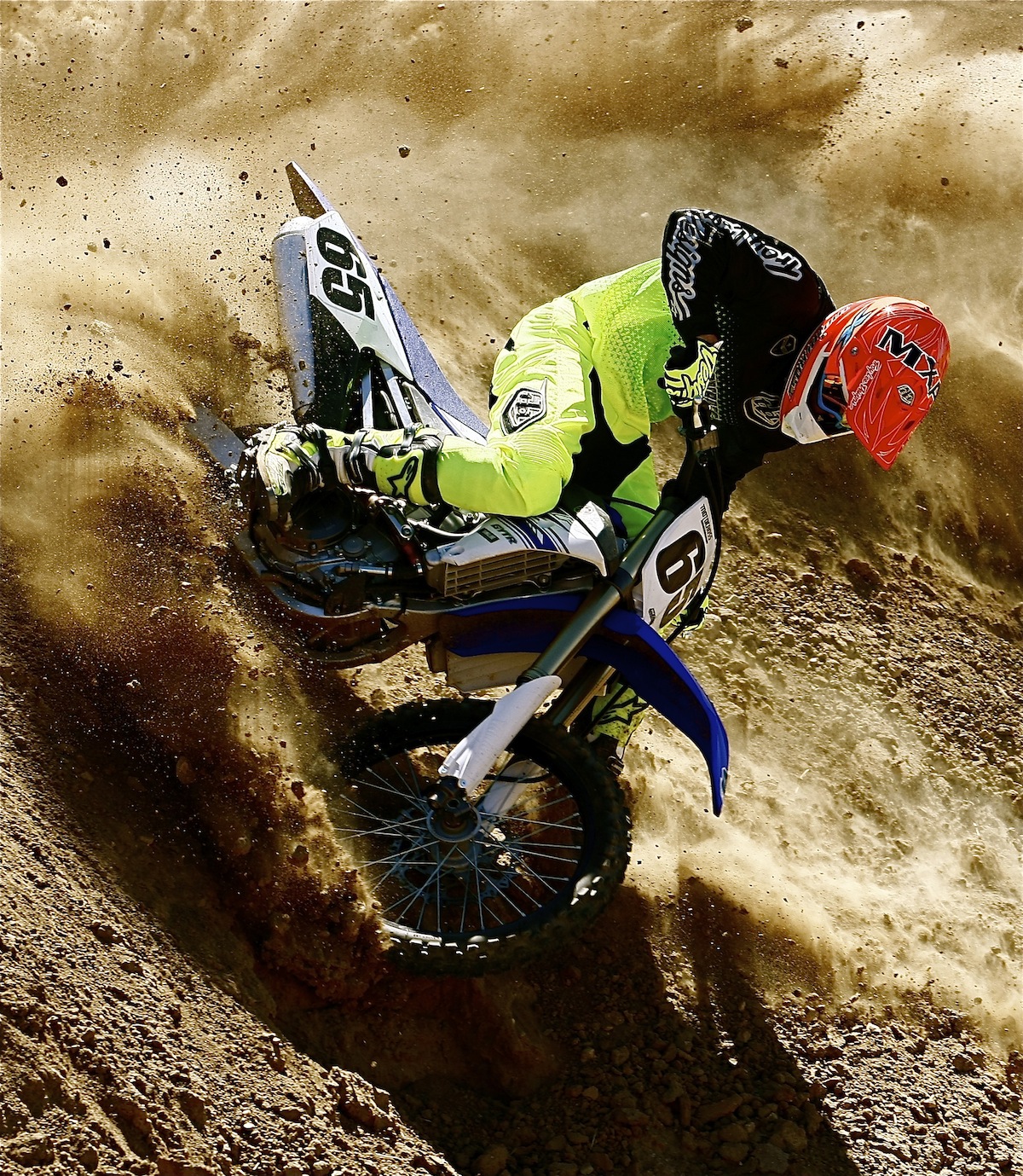2016 MXA RACE TEST: EVERYTHING YOU NEED TO KNOW ABOUT THE YAMAHA YZ450F
Q: FIRST AND FOREMOST, IS THE 2016 YZ450F BETTER THAN THE 2015 YZ450F?
A: Yes, but the changes are small qualitative steps as opposed to a major overhaul of the existing 2015 YZ450F.
Q: WHAT CHANGES DID YAMAHA MAKE TO THE YZ450F ENGINE?
A: Don’t forget that the YZ450F was brand new for the 2014 model year. Under the current pattern of four-year development cycles, any changes to the bike this year are icing on the cake, because a new bike isn’t in the cards until after 2017. That said, Yamaha did try to address some engine issues that MXA was critical of. All of these parts can be retrofit on a 2014–’15 YZ450F. Here is the list:
(1) Cams. The exhaust cam has 0.3mm more lift. Valve lift is the distance that the valve is lifted off of its seat. Increasing valve lift, without increasing duration, can yield more power without much change to the nature of the power curve. On the 2016 Yamaha YZ450F, the exhaust cam opens the valves later, closes them sooner and has a duration of 8 degrees less. Most important, the overlap was decreased from 80 degrees to 68 degrees (at high engine speeds, overlap allows the rush of exhaust gases out the exhaust valve to help pull the fresh air/fuel mixture into the cylinder through the intake valve). The intake cam has 0.1mm less lift, which for all intents and purposes is neglig-ible. What does all that mumbo-jumbo mean? There is more low-end power and a better transition into the middle.
(2) Valve springs. The 2016 valve springs are slightly stiffer than the 2015 springs. More important, the spring design has been changed to eliminate coil bind at high rpm.
(3) Gear stop lever. In 2014, there were some failures of the ball bearing-equipped roller on the gear stop lever, so in 2015, the ball bearings were replaced with a plain roller, which would not explode like the ball bearings had. For 2016, the gear stop lever not only gets a 20-percent-stiffer spring, but the plain roller is now supported on both sides of the stopper arm.
(4) Dog shape. Yamaha has changed the dog shape on the gears to allow for more precise shifting, especially on the previous weak link while up-shifting. Additionally, the gap for neutral has been reduced to lessen the chance of accidentally popping the bike out of gear while racing.
(5) Clutch pressure plate. A new machining process on the clutch surface of the YZ450F pressure plate ensures a smoother and flatter gripping point for the clutch. The 2015 pressure plate was rougher at the micron level.
(6) Impeller. Yamaha has installed a new impeller in the water pump; however, the impeller’s shape, vanes and dimensions remain unchanged. Instead, Yamaha drilled holes in the backing plate of the impeller to relieve pressure on the seal side. This equalizes pressure on both sides of the pump and improves water pump seal life.
 2016 Yamaha YZ450F: The best reasons to buy a Yamaha YZ450F is that it has great SSS suspension, is blazing fast at high rpm, and you can’t break it (even if you try).
2016 Yamaha YZ450F: The best reasons to buy a Yamaha YZ450F is that it has great SSS suspension, is blazing fast at high rpm, and you can’t break it (even if you try).
Q: WHAT IS THE MOST NOTEWORTHY CHANGE ON THE YZ450F ENGINE PACKAGE?
A: Launch control. Okay, we can already hear you sighing “ho-hum” and yawning at the idea of another bike with launch control—after all, Suzuki, KTM, Husqvarna and first adopter Kawasaki all have the same basic systems on their bikes. But hold on to your hats; Yamaha has upped the ante, even though Yamaha uses the same button as Suzuki and Kawasaki. How so? From 4500 rpm and at 30 percent throttle opening, Yamaha’s launch control system reduces horsepower much more than the competing systems. Less horsepower translates into less wheelspin and more forward hook-up. “Ho-hum. That’s how they all work,” you say? Think again. Once the YZ450F clears the starting gate and travels between 30 and 60 feet off the line, the horsepower ramps back up to max power without you doing a thing. That is a sweet deal. With the typical launch control system, the rider gives up 4 horsepower all the way until he shifts to third gear. With the Yamaha Launch Control System (YLCS), full power is restored once the rpm and throttle position sensors prove to the ECU that the bike is no longer in roll-on power mode. It will automatically shut off when you shift to third.
Q: WHAT CHANGES DID YAMAHA MAKE TO THE 2016 YZ450F CHASSIS?
A: You don’t need Dr. Watson to tell you that Yamaha’s goal with the YZ450F engine was to boost low-to-mid power to complement the already amazing top end. As for the chassis, Yamaha is trying to chase away the demons that its frames have been tormented by at turn-in for the last decade. The 2014 frame was a step in the right direction, but the loose feeling on the entrance to corners was not totally eliminated. For 2016, Yamaha’s engineers focused their attention on “refined stability when aggressively entering corners.” They attacked the chassis with a six-point modification program, which will retrofit on 2014–’15 YZ450Fs.
Here is the short and tidy list of the Yamaha chassis mods.
(1) Triple-clamp offset. The fork offset has been changed from 22mm to 25mm. This may seem like an earth-shattering move on the geometry front, but in reality it is just a return to the previous offset. The 3mm offset change decreases the amount of trail in the front wheel. This change in trail has a symbiotic relationship to the next chassis change that Yamaha made for 2016.
(2) Shock spring. The rear shock spring has been changed from 58 N/m to 56 N/m. Normally, a lighter spring rate is chosen to accommodate a lighter rider, but Yamaha is still aiming for its original 175-pound target audience. So, why go to a softer shock spring? To allow the rear of the YZ450F to settle a little deeper into its stroke. On the positive side, this settling improves overall traction at the rear wheel. On the negative side, it drops the rear of the bike and kicks the steering head angle out, which increases trail. Thus, to get the trail back to where it needs to be, Yamaha paired the greater offset triple clamps with a softer spring rate to bring the dimensions back into sync.
(3) Chassis stiffness. To maximize the frame geometry, Yamaha wanted to stiffen the chassis torsionally to lessen twisting loads under hard acceleration. The engineers did this with wider forgings at the swingarm pivot. A close look at the aluminum parts next to the rider’s boots will reveal that they extend rearward 12mm more than last year’s forged pieces. This provides not only stronger support for the swingarm and rear motor mount, but lessens twisting of the chassis to improve stability and bump absorption.
(4) Head stays. To fight against any engine shake or chassis flex at the front of the frame, the head stays are bigger, thicker and stronger.
(5) Footpegs. The YZ450F footpegs have been lowered 5mm. This change is not made to the frame or the mounting brackets but to the footpegs themselves, which means that they will retrofit on the 2014–’15 models for riders who want to lower the bike’s weight or make the cockpit a little roomier.
(6) Front brake. It’s better to be late to the party than to miss it altogether. The 2016 Yamaha YZ450F gets a 270mm front rotor to boost its braking power. The stronger brake will help settle the YZ450F chassis at turn-in, because the previous 250mm brake wasn’t able to stop the blue beast with any alacrity.
 Power shift: New cams give the YZ450F better throttle response from low-to-mid, but peak power is the same.
Power shift: New cams give the YZ450F better throttle response from low-to-mid, but peak power is the same.
Q: IS ANYTHING ELSE NEW ON THE 2016 YAMAHA YZ450F?
A: Yes. The fabulous Kayaba SSS suspension has been tweaked with minor valving changes front and rear. The fuel-injection mapping has been reconfigured, and the graphics have been updated. For those who would like to relive the glory days, the YZ450F is also available in a 60th Anniversary Yellow edition (for a $100 surcharge).
Q: HOW DOES IT RUN ON THE TRACK?
A: We suppose the real question to ask is whether the 2016 Yamaha YZ450F is faster than the 2015 model. It is, but, then again, it isn’t. The 2014 model actually had a little more oomph than either the 2015 or 2016—attributable to its one-tooth-lower gearing and more aggressive mapping. That said, the 2016 Yamaha YZ450F stands apart from its two brethren in that the cam change and 3% leaner mapping fill in the bottom of the powerband where the previous YZ450Fs were weak. What you get with the 2016 YZ450F is an easier-to-ride bike in the slower sections of the track. It has half-throttle options that last year’s engine didn’t have, plus you have full knowledge that once you get to 9000 rpm, you will be riding a rocket to the moon. This has always been a very fast bike at high rpm, but now the bottom end is torqued up to make it more responsive off idle.
We did try different maps on the 2016 YZ450F and had some luck with advancing the timing for a sharper feel, but overall the stock map provided the best all-around power.
As always, there were issues with the YZ450F transmission feeling a little gappy. This has been a problem since 2014 when Yamaha tried to fix one tranny problem and inadvertently caused another. Our biggest shifting issue has alway been on the upshift from second to third. We resorted to an old trick, which was standard on the 2014 YZ450F—a 49-tooth rear sprocket in place of the stock 48.
This gave us more thrust from gear to gear and allowed us to get to third gear sooner, where the increase in low-to-mid power could be used to its fullest.
 Take-off: Yamaha’s launch control button is borrowed, but their take on how launch control works is unique.
Take-off: Yamaha’s launch control button is borrowed, but their take on how launch control works is unique.
Q: HOW DOES IT RUN ON THE DYNO?
A: We didn’t expect Yamaha’s engine mods to result in more peak horsepower since they were designed to fluff up the low-to-mid and not the top. It should be noted that the top doesn’t need any help. The 2016 Yamaha YZ450F’s peak horsepower was 56.85 at 9800. That’s fast, although the peak is rather high in the rpm range. The 2015 YZ450F made 56.90 horsepower.
Just as Yamaha’s engineers promised, we saw an increase in both low-end horsepower and torque from 5000 rpm to 6500 rpm. After that, the 2015 and 2016 powerbands were fairly identical.
Q: KAYABA SSS SUSPENSION OVER AIR FORKS?
A: You bet. Compared to the forks on the Kawasaki, Honda, KTM, Suzuki and Husqvarna, the box-stock Kayaba SSS forks are “works” forks. They are so much better than the new breed of air forks that it’s no contest. But air forks have two major advantages over Kayaba SSS forks: (1) Air forks cost the manufacturers a lot less to purchase. Why are they cheaper? They don’t have expensive coil springs. They only have parts-intensive valving in one leg instead of two. And, they are easier to assemble at the factory. Unfortunately, while they may be cheaper to produce and install at the factory, the consumer price does not reflect the cost savings. (2) Air forks are lighter than Kayaba SSS forks. How much lighter? Two pounds (based on the fact that there are no coil springs and one fork leg is effectively an empty tube filled with air).
How long can Yamaha’s R&D department ignore the weight and dollar savings just to spec the best forks on the track? We hope they turn a blind eye to air forks for a long time.
 On the binders: Yamaha has stepped out of the Fred Flintstone era of front brakes with a 270mm rotor.
On the binders: Yamaha has stepped out of the Fred Flintstone era of front brakes with a 270mm rotor.
Q: HOW DOES THE 2016 YZ450F HANDLE?
A: At first we didn’t notice any major improvements in the way the Yamaha cornered. It was still vague at tip-in and tended to push on flat corners. But, we had faith that the changes that the Yamaha engineers made would pay dividends. We decided that we couldn’t rely on our previous setup information and decided to take a different approach to the 2016 YZ450F. So, we started from scratch and worked our way through the possibilities.
In the end we slid the forks up in the clamps to steepen the head angle and to put more weight on the front wheel. We swapped the stock Dunlop MX52 for an MX32—a good front tire that civilizes the YZ450F at tip-in. We changed the rear sag from 100mm to 103mm. We turned the high-speed compression out a half turn to help the rear settle a little more under load. We went to a longer shock linkage to lower the rear of the bike even more. And, we added a tooth to get us to third gear sooner, which helped calm the chassis compared to rattle canning it into every corner in second gear. These fixes helped make the YZ450F do what we wanted it to.
We don’t blame any rider who has issues with the way the YZ feels on the entrance to flat or sweeping turns. It can be awkward-feeling, and we have been critical of the front-end response of the YZ450F since 2007. Any rider with a handful of tools and an afternoon of riding time can nibble away at the loose feeling with incremental adjustments, but there are concerns. In stock trim, it feels too tall in the rear. It gives the false impression that it’s overly wide at the radiators, probably because it flares out from very thin to its widest point in a short distance. It isn’t flat enough for our tastes. And given the new direction set by the KTM 450SXF, it is too heavy at 238 pounds without gas (that is 11 pounds more than the 227-pound KTM and 5 pounds more than the CRF450).
Q: WHAT DID WE HATE
A: The hate list:
(1) Yama-thumb. When the stock market settles down, invest in a company that makes grip donuts.
(2) Dzus fasteners. We expected the annoying Dzus fasteners to be gone this year. They are a good idea gone bad. The two fasteners on the sides of the gas tank fall out—or rip your pants and then fall out. The quick fix is to put tape over them, but we remove the D-rings—and use a screwdriver to remove the bolts when we need to get into the airbox.
(3) Gearing. Experiment with a 49 for your local track.
(4) Noise. You’ll get used to the unsyncopated rhythms coming from the airbox as long as you never ride another brand of bike. But if you do ride another brand, you’ll find that riding the YZ450F is like having a boom box in your lap.
(5) Radiator wings. We much prefer the Cycra radiator shrouds over Yamaha’s double-wall intake system. Yamaha’s system looks like it was designed by a heating and air conditioning technician. Yamaha’s airbox designer could do the same thing with 2 fewer pounds of plastic.
(6) Gas-cap vent hose. It reminds us of one of those tubes that they stick in you after you have a bad crash. There must be a better way to vent the gas cap than a random hose sticking straight up. Oh yeah, don’t tighten the gas cap too tight, because for some reason it tightens itself too tight without your help.
(7) Weight. Not that many years ago, if a 450 was under 240 pounds it was considered light. But, 238 pounds doesn’t cut the mustard today. This bike is 11 pounds heavier than a KTM 450SXF (and it has an electric starter). You don’t want to know how much money it would cost to make the YZ450F weigh 227 pounds.
(8) Exhaust pipe. We like it until we have to remove it. Then we hate its Rube Goldberg mounting system.
 The new triple clamps are really the old triple clamps.
The new triple clamps are really the old triple clamps.
Q: WHAT DID WE LIKE?
A: The like list:
(1) GYTR Power Tuner. The GYTR Power Tuner ($291.95) is the easiest-to-use programming tool in the sport. It’s like a Playstation for your fuel injection. The other brand’s mapping systems are Rubik’s Cubes.
(2) Suspension. Kayaba’s old-school forks put all the fancy air forks to shame. The buzz of air forks will have a hard time beating the actual performance of Yamaha’s SSS units.
(3) Reliability. Nothing is as reliable as a Yamaha YZ450F.
(4) Clutch. We admit to adding stiffer clutch springs, but after Husky’s and KTM’s hydraulic clutches, the YZ450F is third best.
(5) Power. This bike is fast. Not because it makes the most horsepower, but because it keeps building horsepower until it is very high in the rpm band.
Q: WHAT DO WE REALLY THINK?
A: This is a very good race bike. It has an improved powerband, awesome suspension, updated brakes and world-renowned reliability. But it’s not without flaws. Sometimes flaws can be written off as personality quirks as opposed to deal-breakers—that’s how we like to look at the 2016 Yamaha YZ450F. It’s quirky.

MXA’S YAMAHA YZ450F SETUP SPECS
This is how we set up our 2016 Yamaha YZ450F for racing. We offer it as a guide to help you find your own sweet spot.
KAYABA SSS FORK SPECS
Companies that have latched on to air forks are gambling with your money. Yamaha’s SSS suspension is a sure thing. Maybe eventually air forks will be this good, but that’s not today’s reality. For hard-core racing, these are MXA’s recommended 2016 Yamaha YZ450F fork settings (stock settings are in parentheses).
Spring rate: 5.0 N/m
Oil quantity: 315cc
Compression: 10 clicks out (8 clicks out)
Rebound: 8 clicks out (10 clicks out)
Fork leg height: 4mm up
Notes: Yamaha discovered in 2015 that it could run stiffer fork springs and get softer forks. For 2016, Yamaha has refined what were already the best forks on the market. What’s best about them? They work for Beginners, Novices and AMA Pros. They don’t care if you’re thin or fat, tall or short; they have a setting for everyone.
KAYABA SHOCK SETTINGS
Yamaha’s idea of going to a softer shock spring and then changing the offset on the forks to compensate for the spring change has a Looney Tunes ring to it. We can think of four different ways to achieve the same thing. One thing we do know: once you preload the soft spring for your weight, it is not going to ride lower, because when you preload a spring, you increase its spring rate. The more you preload it, the stiffer the spring becomes in the first inch of travel. This means that 100mm of sag will always be 100mm of sag. Oh well, it’s all a numbers game, and anything can be made to work with enough testing.
For hard-core racing, these are MXA’s recommended 2016 YZ450F shock settings (stock settings are in parentheses).
Spring rate: 56 N/m
Race sag: 103mm (100mm)
Hi-compression: 2 turns out (1-1/2 turns out)
Lo-compression: 12 clicks out
Rebound: 9 clicks out (14 clicks out)
Notes: We ran a longer 143.5mm Pro Circuit shock linkage—not solely for suspension purposes, but also to give us more adjustment room with the head angle and frame geometry. The longer link will drop the rear of the bike almost 8mm and stiffen the initial part of the stroke. We compensate for this move by turning the high-speed compression out a half turn and the rebound in 5 clicks. This is one of the changes that Yamaha could have made without the story line.
MXA’S 2016 YAMAHA YZ450F VIDEO










Comments are closed.